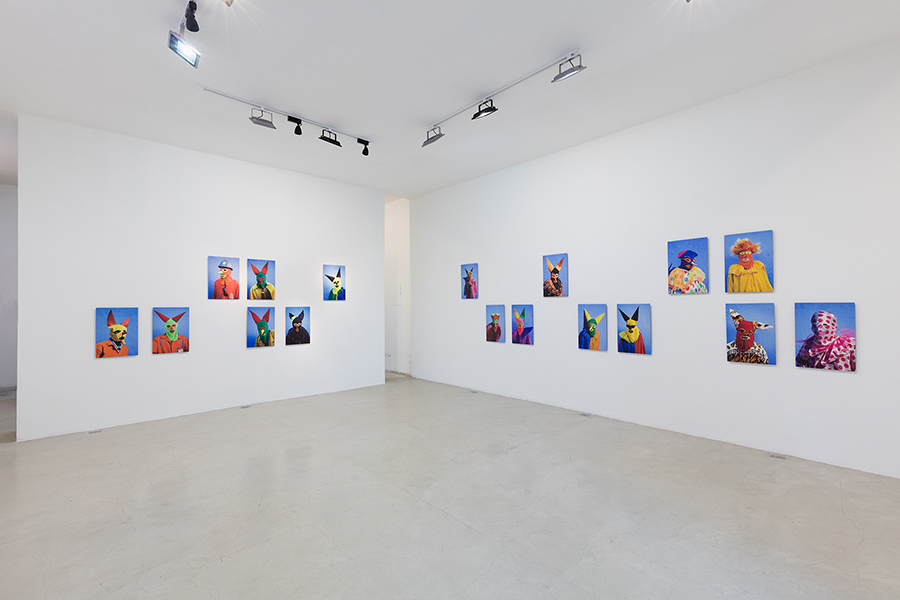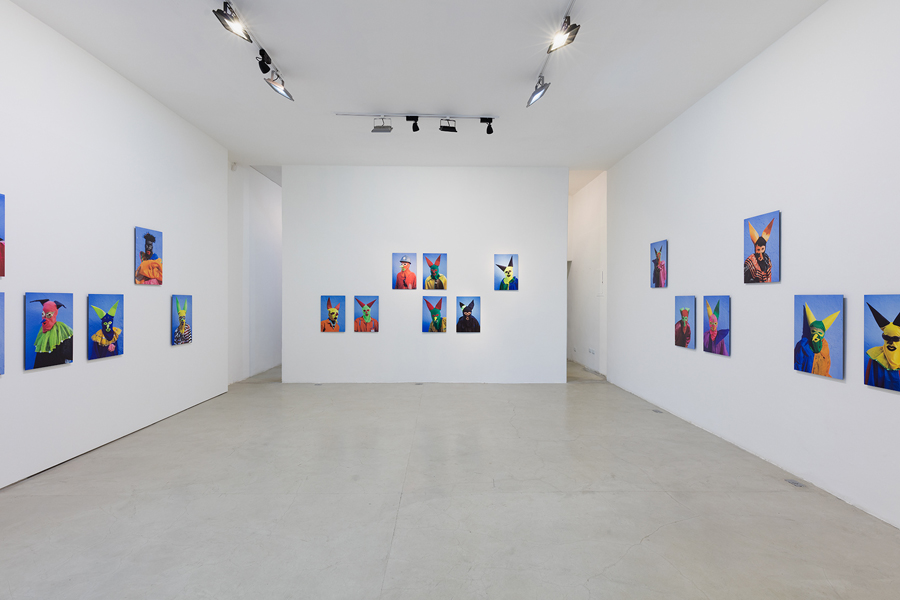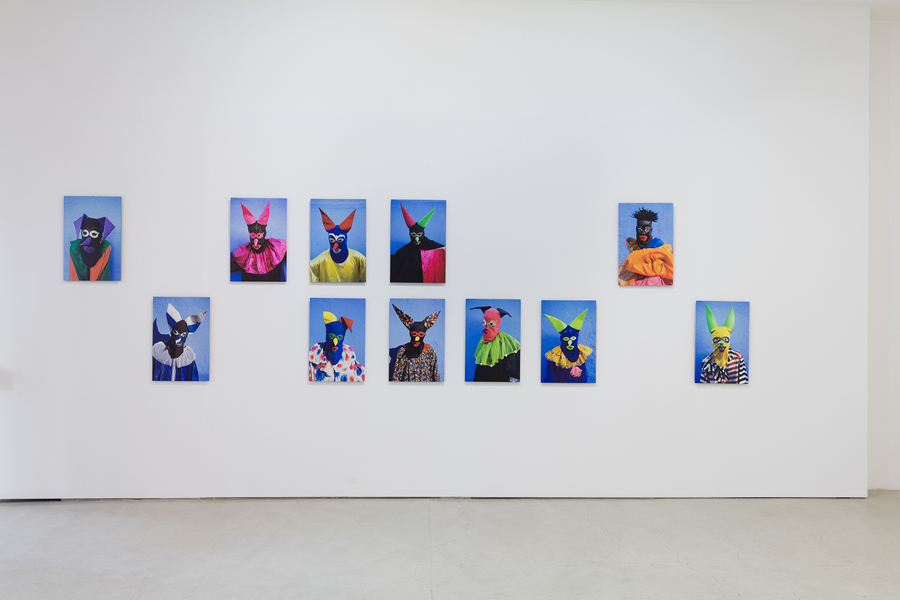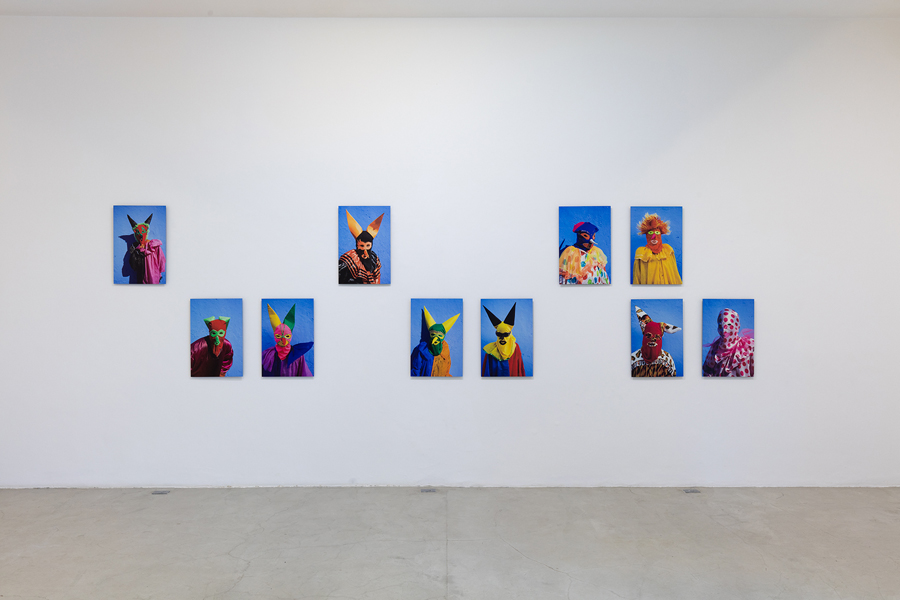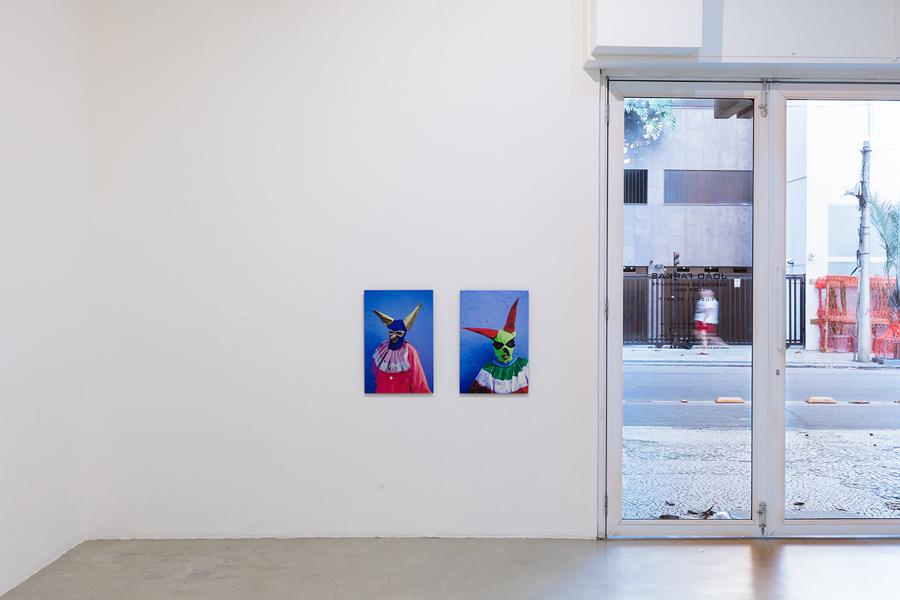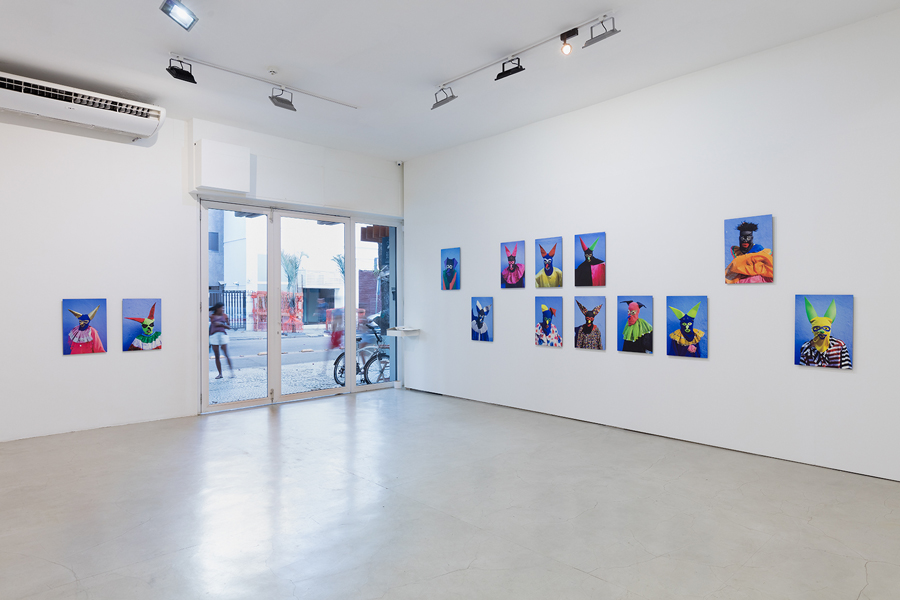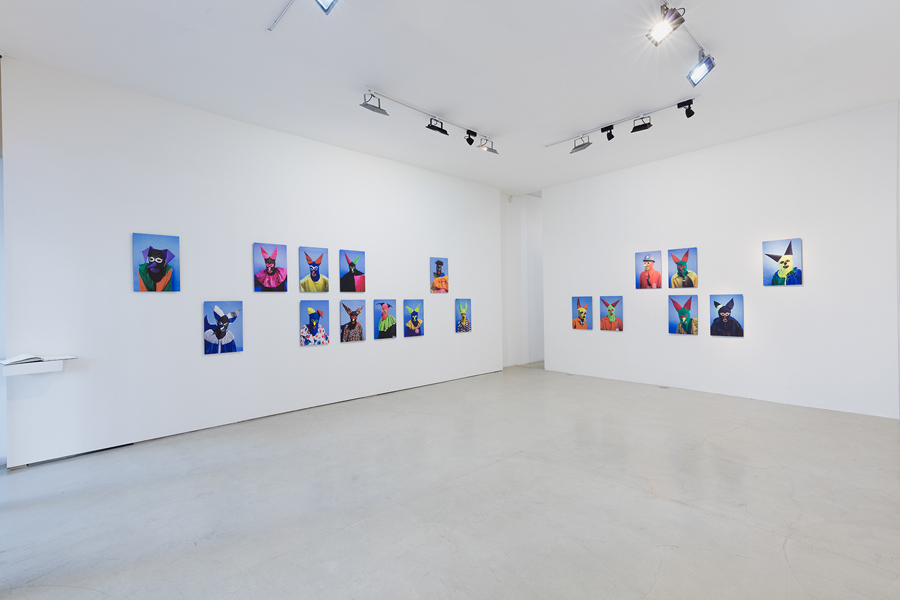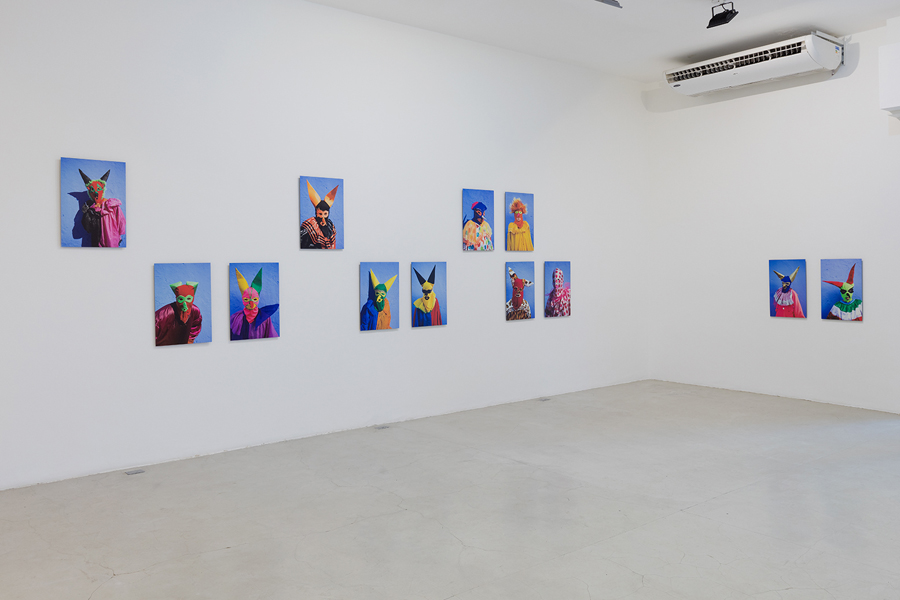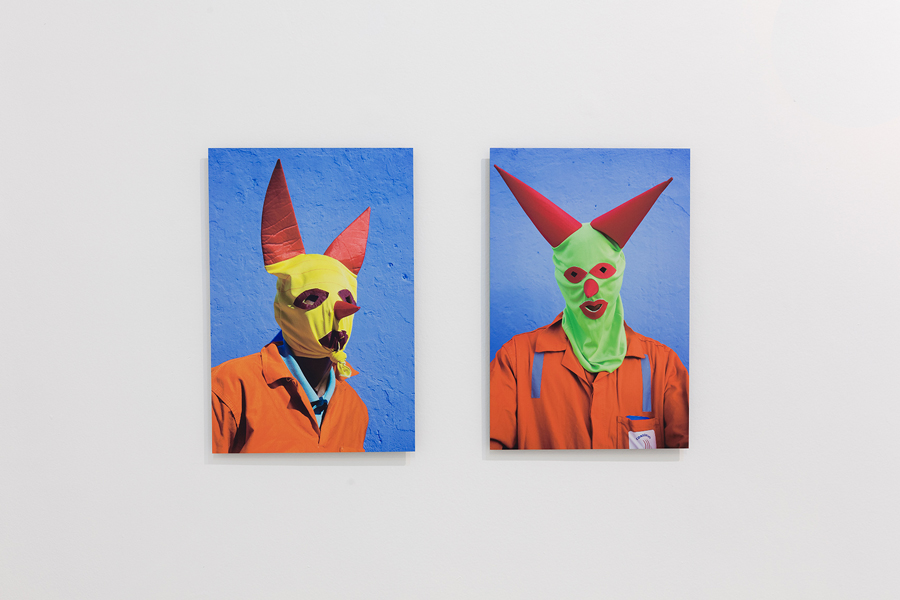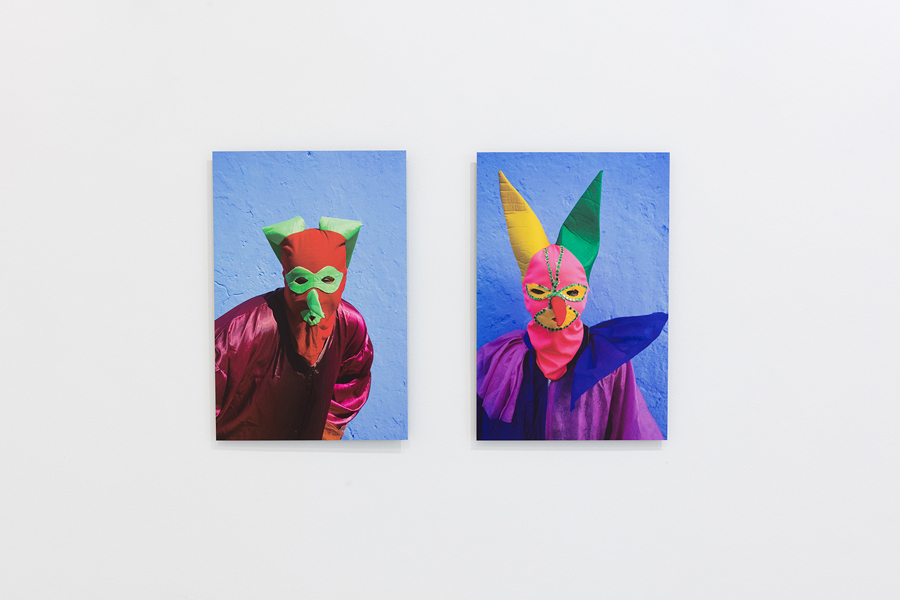galeria marcelo guarnieri | rio de janeiro
abertura
09.02.2017 / 18h – 21h
período de visitação
09.02 – 11.03.2017
Rua Teixeira de Melo, 31 – lojas C/D
Ipanema – Rio de Janeiro – Brasil
[ mapa ]
EM TOM DE AZUL
por Diógenes Moura
Ah clareiras, ah mundo
ah coisas do acontecido
no oculto fundo.
Surjo, insurjo-me,
À teia da bruma espuma:
Sei que cresço
– respondeço
em azul de noturno mar.
Lucio Cardoso
Nunca esqueci uma fotografia de Pierre Verger feita em Salvador, na década de 1950. Ali, um personagem sem sexo fuma encostado na porta da Santa Casa de Misericórdia da Bahia. Ao seu lado uma criança quase sorri porque viu o fotógrafo no instante preciso “enxergar” por trás da câmera aquela figura com uma máscara de careta, um vestido quase mortalha, a perna esquerda aparecendo na fenda da roupa e um mistério que vai cruzar a linha do tempo numa fotografia: homem ou mulher, ou os dois, ou mais adiante? Quem estaria embaixo da máscara de careta, na porta de uma igreja precisamente num período em que no carnaval de Salvador os caretas com suas mortalhas faziam a festa com a leveza da voz fina para não serem identificados. Careta, quem sou eu? Careta, quem é você? Com o passar dos anos as mortalhas foram desaparecendo. Deram lugar aos enfadonhos abadás sintéticos num carnaval onde o varejo faz com que todos sigam iguais dentro dos blocos de trios elétricos. As máscaras dos caretas se diluíram aparecendo atualmente na cidade em pequenos grupos, em busca de resquícios de um passado-presente porque necessitamos dos dois.
A família Farkas tem raízes quase ancestrais com a Bahia. Thomaz Farkas, o pai, sempre me disse que gostaria de ser baiano. João Farkas, o filho, hoje tem ao lado da família uma morada na praia de Busca Vida e recordações desde a década de 1960, quando eram hóspedes dos Amado, na casa da Rua Alagoinhas, no Rio Vermelho. João me escreveu contando que foi nas barracas do mercado que aprendeu “com a mão espalmada de Mestre Didi que Deus é um só, embora os caminhos até Ele sejam muitos” e que ouvia “o Hino do Bahia e do Nosso Senhor do Bonfim na voz de Caetano Veloso de cabelos raspados, naqueles anos em que a barra era pesada e o homem pisava na lua”. Também me disse que foram os vizinhos que o levaram a Maragojipe “onde o povo resiste e o carnaval não quer morrer”. Esse carnaval que vai além da dor. Que vai além do calor. Que vai além do desejo. Que vai além da pobreza. Que vaza por todos os limites de um Brasil à beira entre violência e paixão.
Então ele, João, também transbordou com tudo o que viu e ouviu e tudo fotografou nos dois primeiros anos de sua saga maragojipana. Só quando voltou pela terceira vez é que se fixou nos retratos e no silêncio, na fantasia dos outros, na máscara dos caretas anônimos, das costureiras anônimas, das vozes anônimas, dos homens, das mulheres, das crianças, dos velhos, dos brancos e dos pretos. Do homem-mulher e da mulher-macho. De tudo isso e de um retrato diante de uma parede azul. De um retrato do “outro” que não sabemos quem é, mas que somos “nós mesmos”. De um retrato brasileiro renascido dos entrudos, das matrizes africana e indígenas, das tribos Maragós (aqueles dos braços invencíveis) que por ali viveram no início de tudo.
E mesmo com o rosto encoberto um retrato será sempre um veredito. Está acima de uma identidade não revelada. É como um livro aberto. É um segredo de um segredo. A Série Azul é um segredo que o fotógrafo tenta descobrir procurando “enxergar” a si mesmo ali, do outro lado da câmera. Como naquela fotografia de Verger. Como no poema de Lúcio Cardoso. É um segredo que nos pertence. Que tem reflexos de nós mesmos explodindo em cores até agora, futuristas. Estamos dentro de cada um desses mascarados. Guardados e expostos. Em azul de noturno mar. Diante do fotógrafo e de nós mesmos, como quem pergunta: quem é você? O que seu retrato quer de mim? É disso que se trata.
galeria marcelo guarnieri | rio de janeiro
opening
February 09, 2017 / 6 – 9pm
exhibition
09.02 – 11.03.2017
Rua Teixeira de Melo, 31 – lojas C/D
Ipanema – Rio de Janeiro – Brasil
[ map ]
IN A BLUE TONE
by Diógenes Moura
Ah glades, ah world
ah, things from the happened
in the hidden background.
I arise, I rise up,
To the web of mist foam:
I know I grow up
– I respond
In a blue of nocturnal sea.
Lucio Cardoso
I never forgot a photograph of Pierre Verger taken in Salvador in the 1950s. There, a sexless character smokes leaning against the door of the Santa Casa de Misericórdia da Bahia. Beside this figure, a child almost smiles because he saw the photographer, at the precise moment, “watch” behind his camera, that figure with a face mask, a dress that is almost a shroud, the left leg showing through the slit of the clothing and a mystery that will cross the line of time in a photograph: man or woman, or both, or beyond? Who would be under the grimace mask, at the door of a church precisely at a time when in Salvador’s carnival the grimaces, with their shrouds, made the feast with the softness of the voice so they were not identified. Grimace, who am I? Grimace, who are you? Over the years, the shrouds disappeared. They gave way to the boring synthetic “abadás” in a carnival where the retail makes everybody looks the same inside the blocks of electric trios. The masks of the grimaces got diluted, appearing today in the city in small groups, in search of remnants of a past-present, because we need both.
The Farkas family has almost ancestral roots with Bahia. Thomaz Farkas, the father, always told me that he would like to be a Bahian. João Farkas, the son, has today, with his family, an address on the beach of Busca Vida and memories since the 1960s, when they were guests of the Amado family, in the house of Rua Alagoinhas, in Rio Vermelho. João once wrote telling me that it was in the market stalls that he learned “with the flat hand of Mestre Didi that God is one, although the paths to Him are many” and also that he heard “the Anthem of Bahia and of Nosso Senhor do Bonfim in the voice of a shaven head Caetano Veloso, in those rough years when the man stepped on the moon”. He also told me that it was his neighbors who took him to Maragogipe “where the people resist and the carnival doesn’t want to die”. This carnival that goes beyond the pain. That goes beyond the heat. That goes beyond desire. That goes beyond poverty. That leaks through all the limits of a Brazil on the verge of violence and passion.
Then he, João, also overflowed with everything he saw and heard, and photographed everything in the first two years of his Maragogipan saga. It was only when he returned for the third time that he noticed the portraits and the silence, the costumes of others, the mask of the anonymous faces, the anonymous dressmakers, the anonymous voices, the men, the women, the children, the old, the white people, the black people. Man-female and woman-male. Of all this and of a portrait before a blue wall. From a picture of the “other” that we don’t know who it is, but that are “ourselves”. From a Brazilian portrait re-born of the indents, the African and indigenous matrices, the Maragós tribes (those of invincible arms) that lived there at the beginning of everything.
And even with the face covered, a portrait will always be a verdict. It is above of an undisclosed identity. It’s like an open book. It’s a secret from a secret. The Série Azul is a secret that the photographer tries to figure out by “looking” at himself, on the other side of the camera. Like that picture of Verger. As in the poem of Lucio Cardoso. It’s a secret that belongs to us. That has reflections of ourselves exploding in colors so far, futuristic. We are inside each of these masquerades. Stored and exposed. In night blue sea. Before the photographer and ourselves, as if asking: who are you? What does your picture want from me? That’s what it’s all about.

